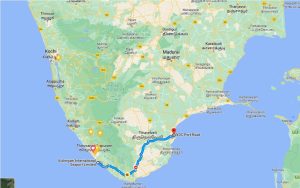
Infrastructure in the Deep Peninsula for National Security and Self-reliance

A Swarajya report https://swarajyamag.com/infrastructure/vo-chidambaranar-port-to-expand-with-rs-7200-crore-project-to-compete-with-colombo-and-singapore-as-transhipment-hub about VOC port in Thoothukkudi (Tuticorin), Tamil Nadu, and its plans to expand into a container trans-shipment port was interesting. It reminded me of a plan I have mooted for some time (without success so far) about building up logistics infra, industrial capacity and defense capability in the deep south.
Briefly, India’s much-desired success as a manufacturing and export power will be compromised unless there is good transportation infrastructure for both bulk cargo and for high-value, low-weight industrial goods. Today, India’s container cargo is highly dependent on Colombo, Singapore and Dubai for trans-shipment (that is, transferring cargo from the giant motherships to smaller ships). Approximately, 25% of India’s containers transit through Colombo alone.
Colombo, in fact, depends on India for over 70% of its business. Their existing East Terminal is Chinese-controlled; the proposed West Terminal is apparently taken up by India’s Adani group on a BOT basis. Nevertheless, it is possible to imagine that at a point of geo-political stress, as with Sri Lanka’s troubles today, or if the Chinese decide to embargo Indian containers (as they did without notice for exports of rare-earths to Japan), Indian trade could be badly affected.
The under-construction Vizhinjam port in Trivandrum, also controlled by Adani Ports, has a proposed capacity of 1.8 million TEUs in the first phase, and 5.3 million TEUs in the second phase. The proposed VOC container terminal at Thootthukkudi will have a capacity of 4 million TEUs. (A TEU or twenty-foot equivalent can be taken to be a single container for practical purposes).
The right solution would be for these two ports to work in coordinated fashion, one on each side of the Peninsula, and not getting into destructive competition.

Image courtesy Swarajya Magazine.

Road connectivity Image: Courtesy Google Maps

Rail connectivity (upto Tirunelveli), image courtesy Google Maps
My idea has been a railway line and an industrial corridor linking the two, which are roughly 200 km apart by road. Both ports have their advantages, and together they can serve a significant hinterland, and the proposed developments between them can provide a measure of maritime security in an area that has been neglected so far, but will become increasingly critical.
There are three aspects to it: connectivity, a focused industrial corridor, and security.
Connectivity, Shipping Routes and Trunk National Rail and Road Links
Vizhinjam has a multi-modal advantage: the port is only 15 km from a major international airport, and both the port and the airport are controlled by Adani Ports, so that they could coordinate multi-modal shipment of goods, including at some point, inland waterway transport via National Waterway Three. Thoothukkudi airport is much smaller.
But both are linked to the national trunk routes of the Golden Quadrilateral highways and railway lines passing through Tamil Nadu. So container traffic can be moved between the two with relatively little effort; also upcountry containers from/to Bangalore or Hyderabad or further inland can be moved with relative ease down to either of them without much trouble (the connectivity links for both to the trunk routes are either in place or are being built up).
In terms of the shipping lanes in the Arabian Sea, Vizhinjam has the advantage, as it is only 10 nautical miles away from the main lines. VOC is a bit of a diversion, and unless there is some incentive, very large container ships (12000+ TEU for instance) would hesitate to steam the additional nautical miles. Vizhinjam also has the advantage in draft (undredged 16m). However, the TN government is good at getting things done, so that’s Thoothukkudi’s advantage.
Industrial Corridor: Aerospace
There is a surprising industry that could well be the focus of this corridor: aerospace. There is Thumba and Valiyamala in Trivandrum where ISRO has major facilities, including the rocket-R&D facility named Liquid Propulsion Systems Center. There is Mahendragiri in Tamil Nadu’s Tirunelveli district where the rockets are tested at the ISRO Propulsion Complex. Finally, the new launch pad (after Sriharikota is saturated) is to come up in Kulasekharapattanam in Thoothukkudi dstrict, Tamil Nadu. All these are within a stone’s throw of each other.
The three could form the end nodes for a dedicated aerospace industry cluster. There is no room for manufacturing in congested Kerala (although the R&D can happen there), but it is possible to acquire large tracts of semi-arid land (this being a rain-shadow region, so desalination plants may need to be set up) in Tamil Nadu. India must improve its aerospace industry, both defense and civilian.
There was also talk of Airbus seeking a production facility abroad, but perhaps that opportunity has been lost.

LPSC, Mahendragiri and Kulasekharapatnam of ISRO: Image courtesy Google Maps
India has fallen behind in aerospace; even a developing country like Brazil has its Embraer, and there is no good reason why India cannot have a thriving aircraft industry, perhaps in a niche, especially as civilian air traffic is expected to soar in coming years.
In addition, Tejas and Dhruv have gained a measure of scale with induction into the armed forces, and Brahmos is even being exported (its production base is in Trivandrum now). This means an ecosystem of component suppliers has sprung up. There is no question that India needs to continue to develop its own defense systems, both aircraft and missile, as the possibility of damaging sanctions and technology denial has gone up. Atmanirbhar is the key.
Maritime Defense
Most Indian defense installations have been designed with Pakistan in mind. Thus northwest India and the west coast have been the focus. However, the very real threat of Chinese intrusions into the Indian Ocean needs to be given much more focus now. The Chinese are showing every intent of dominating the Indian Ocean with both surface ships and submarines.
China’s crown jewels (apart from its new aircraft carriers) are the contents of its submarine pen on Hainan Island, near Vietnam’s Haiphong. There are increasing activities by submarines in India’s vicinity. India has little protection and early warning on its east coast. This is one of the reasons that there are new naval installations and long-range radars in the Andamans, which lie close to the mouth of the Straits of Malacca.
It would be a good idea to set up an airbase with long-range radar in southern Tamil Nadu too, to keep an eye on what’s happening in the Bay of Bengal/Indian Ocean area. Besides, surveillance with Poseidon P8i type submarine hunter-killer aircraft could be useful. I remember when I worked in Mountain View, California, I could see from my office Orion P3i craft taking off and landing incessantly at Moffett Field.
India does have important assets on the south-eastern seaboard. One example would be the Koodankulam nuclear plant. I suppose Kulasekharapatnam would also be a potential target for hostile forces. Sterlite would have been if only it hadn’t already been sabotaged.
The deep south has not gotten its fair mind-share. It is time to change that, and in ways that will benefit the rest of the country through efficient trade networks, manufacturing clusters, and defense.
**************
Reference for cover image – vizhinjam port images – Bing images
Disclaimer
The opinions expressed in this article are the author’s own and do not reflect the views of Chanakya Forum. All information provided in this article including timeliness, completeness, accuracy, suitability or validity of information referenced therein, is the sole responsibility of the author. www.chanakyaforum.com does not assume any responsibility for the same.
Chanakya Forum is now on . Click here to join our channel (@ChanakyaForum) and stay updated with the latest headlines and articles.
Important
We work round the clock to bring you the finest articles and updates from around the world. There is a team that works tirelessly to ensure that you have a seamless reading experience. But all this costs money. Please support us so that we keep doing what we do best. Happy Reading
Support Us





















POST COMMENTS (1)
Kalidan Singh